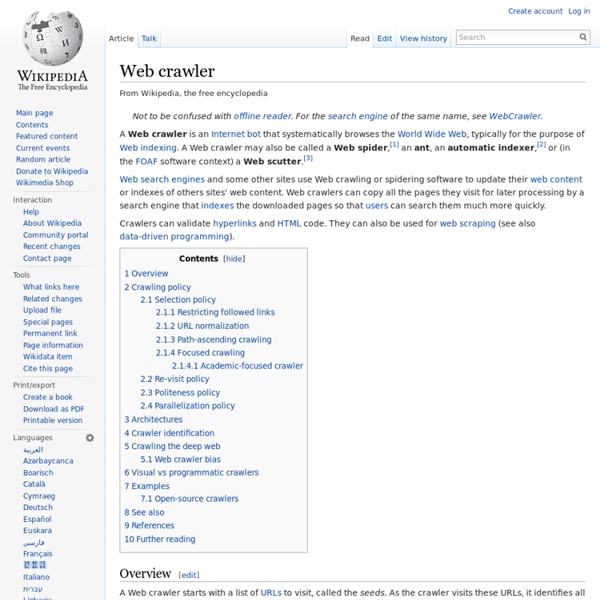Web crawler

Crawl
From Wikipedia, the free encyclopedia Crawl or crawling may refer to: Music[edit] Television and film[edit] See also[edit]
Search engine indexing
Popular engines focus on the full-text indexing of online, natural language documents.[1] Media types such as video and audio[2] and graphics[3] are also searchable. Meta search engines reuse the indices of other services and do not store a local index, whereas cache-based search engines permanently store the index along with the corpus. Unlike full-text indices, partial-text services restrict the depth indexed to reduce index size. Indexing[edit] The purpose of storing an index is to optimize speed and performance in finding relevant documents for a search query. Index design factors[edit] Major factors in designing a search engine's architecture include: Merge factors Storage techniques How to store the index data, that is, whether information should be data compressed or filtered. Index size How much computer storage is required to support the index. Lookup speed How quickly a word can be found in the inverted index. Maintenance How the index is maintained over time.[5] Fault tolerance
List of social bookmarking websites
Defunct sites[edit] See also[edit] Notes and references[edit]
Rich Text Format
The Rich Text Format (often abbreviated RTF) is a proprietary[6][7][8] document file format with published specification developed by Microsoft Corporation since 1987 for Microsoft products and for cross-platform document interchange.[citation needed] Most word processors are able to read and write some versions of RTF.[9] There are several different revisions of RTF specification and portability of files will depend on what version of RTF is being used.[7][10] RTF specifications are changed and published with major Microsoft Word and Office versions. It should not be confused with enriched text (mimetype "text/enriched" of RFC 1896) or its predecessor Rich Text (mimetype "text/richtext" of RFC 1341 and 1521); nor with IBM's RFT-DCA (Revisable Format Text-Document Content Architecture) which are completely different specifications. History[edit] Microsoft holds the rights to the RTF format[citation needed] and maintains the format. Version timeline[edit] Version changes[edit] Objects[edit]
List of document markup languages
The following is a list of document markup languages. You may also find the List of markup languages of interest. Well-known document markup languages[edit] HyperText Markup Language (HTML) – the original markup language that was defined as a part of implementing World Wide Web, an ad hoc defined language inspired by the meta format SGML and which inspired many other markup languages.Keyhole Markup Language (KML/KMZ)[1] - the XML-based markup language used for exchanging geographic information for use with Google Earth.Mathematical Markup Language (MathML)Scalable Vector Graphics (SVG)TeX, LaTeX – a format for describing complex type and page layout often used for mathematics, technical, and academic publications.Wiki markup – used in Wikipedia, MediaWiki and other Wiki installations.Extensible 3D (X3D)Extensible HyperText Markup Language (XHTML): HTML reformulated in XML syntax. [edit] Lesser-known document markup languages[edit] (including some lightweight markup languages) See also[edit]
Related:
Related:



